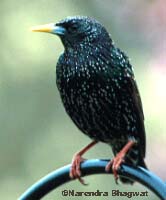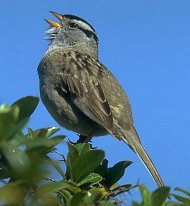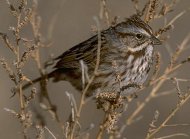Song is used by passerines (songbirds) to attract mates and to maintain breeding territories in the spring and early summer, however, many songbirds also sing in the autumn. If these birds aren’t breeding in the autumn, then why are they singing?

There are at least three physiological mechanisms that apparently underlie autumnal singing in temperate-zone passerines. These physiological mechanisms could also underlie out-of-season singing in tropical and subtropical passerines that are kept and bred by American Aviculturists. Here, I discuss what is known for North American temperate-zone passerines, which are the only bird species for which autumnal singing has been scientifically investigated.
After completing their annual moult, the introduced European Starling, Sturnus vulgaris, actually experiences an increase in testosterone levels circulating in the bloodstream. Increased blood plasma testosterone levels are correlated with both singing and territorial behaviors in many birds. Additionally, increased plasma concentrations of testosterone are associated with many physiological and behavioral changes that are necessary for breeding. Sure enough, Starlings are singing and claiming their nest sites in the autumn months! In the higher latitudes such as Seattle where I live, cold winter weather suppresses breeding in Starlings; however, they do breed in the southern parts of the USA where it is warmer during the winter months. Autumnal breeding is also found in the introduced English Sparrows (also known as House Sparrows), Passer domesticus.A second physiological mechanism is seen in our native White-crowned Sparrows, Zonotrichia leucophrys. In contrast to Starlings and English Sparrows, White-crowned Sparrows are photorefractory in the autumn and early winter months. Photorefractoriness is the condition of being unable to physiologically respond to changes in photoperiod (day length).

One characteristic response to a lengthened photoperiod is an increased level of testosterone or estrogen in the bird’s plasma. High plasma testosterone concentrations are typical of spring and early summer and are known to increase singing and to result in territorial aggression in passerines. High plasma levels of testosterone also seem to trigger production of full glorious song rather than small scratchy phrases of the song. These described changes in behavior and physiology are observed in the spring and early summer when White-crowned Sparrows breed.Scientific studies reveal that singing, but not territorial aggression, appears to be somewhat independent of plasma testosterone levels in White-crowned Sparrows because males, females and even juveniles sing throughout the year. This is important for White-crowned Sparrows because they use song for other purposes besides breeding. Song is used to preserve social structure in this species, which spends the winters in large flocks, roaming around in search of food. Song is important in establishing and maintaining the dominant-subordinate structure of White-crowned Sparrow flocks. The precise hormonal milieu that supports autumnal singing in White-crowned Sparrows is not known; however, it is known that increases in plasma testosterone concentrations do trigger significant increases in the rate of singing behavior in this species.
A third physiological mechanism for autumnal singing has recently been identified in Song Sparrows, Melospiza melodia. Song Sparrows are close relatives of White-crowned Sparrows, yet they have a very different life history from White-crowned Sparrows. Unlike White-crowned Sparrows, Song Sparrows do not migrate and they do not form flocks. Instead, Song Sparrows establish and defend winter territories that may or may not be the same as their summer breeding territories. Interestingly, their winter territories are maintained and defended by either two or three individual birds, and these small groups can have any combination of males and females, although it is my observation that there is always at least one male in the group. The males and females that form these wintertime coalitions may or may not breed with each other the following year (or the previous year). It is possible that these birds are relatives of each other. In fact, the exact relationships between these individuals have never been thoroughly investigated, although we do currently possess the technology to identify the genetic relationships of these birds.

What is DHEA and where does it come from? DHEA is an androgen, which is a close biochemical relative of testosterone, in fact. Although we aren’t yet certain, we think that DHEA is produced by the adrenal glands and probably also by the testes (in the case of male birds) and secreted into the bloodstream. Soma’s work reveals that DHEA is relatively abundant during the autumn months in Song Sparrows. Normally, DHEA is an inert steroid hormone that is barely detectable in birds. However, we know that DHEA can be converted into an active form by unique enzymes. During the autumn, special regions of the Song Sparrow’s brain contain these enzymes that are necessary to convert DHEA into its active form. Many of these enzyme-containing brain regions are associated with birdsong. Providing either extra DHEA or its activated form to Song Sparrows causes them to sing: the birds stopped singing when DHEA activity was blocked.
It has been suggested that this phenomenon described for Song Sparrows might also be in effect in American Robins, Turdus migratorius. It has long been observed that male American Robins also undergo an autumnal singing phase, accompanied by increased aggressive behaviors, similar to Song Sparrows.
To summarize, there are at least three different physiological mechanisms that appear to trigger autumnal singing in birds. First, there is an actual beginning of the breeding season in autumn that is suppressed by inclement weather that is typical of northern latitudes. This system is seen in European Starlings and English Sparrows. Second, there is the as-yet unclear autumnal singing that is used to maintain social status in migratory and seasonally flocking species. This is typical of the White-crowned Sparrows, where females and juveniles also sing. Third, but certainly NOT last, there is DHEA-dependent autumnal singing that has been partially investigated in Song Sparrows and may also be shared with American Robins.

